Antarctic Fire Hazards
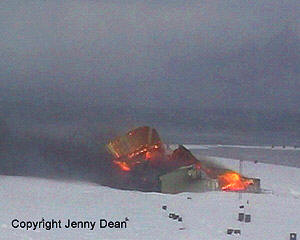
With
the very unlikely exception of some exposed coal seams somehow catching
fire (of which there is no record or evidence) there is really nothing
at all in Antarctica that is naturally there that could burn. 98%
of the continent is permanently covered with snow and ice and the
other 2% is largely bare exposed rock. There is some vegetation,
but nothing more than mosses, lichens and sparse growth of grass
in a few places.
There are no wildland fires in Antarctica.
The fire hazards in Antarctica therefore are faced by the
human habitations of which there are about 65 in total with around
37 being manned year-round, the others are summer-only. Despite
the general lack of combustible materials:
Antarctica is a very dangerous place to have a fire and fire is
in fact the single greatest danger in Antarctica.
The cold temperatures make it very dry, as the windiest place on
earth there is likely to be a wind blowing a gale much of the time
more than strong enough to fan the flames. Finally, due to the temperature
averaging below freezing across the whole continent if there is
a fire, then there is unlikely to be very much liquid water to fight
it with if any at all.
The response usually is to make sure everyone
is out of danger and safe and then stand back and watch the fire
burn itself out - of course attempts are made to fight the fire,
it's just that for the reasons stated above, they are rarely of
any value.
As Antarctica is such an extreme environment and
so remote from any chance of help or rescue, the prospect of a station
being gutted means not only the loss of the building/s, but also
possibly the loss of "life support".
Bases in Antarctica are designed to survive fires
by being made up of a number of separate buildings with a significant
distance between them, if they are connected then it is by small
insubstantial connections. In this way if a building does catch
fire, the chances are the fire won't spread to other nearby buildings.
The First Fire in Antarctica
The first recorded fire in Antarctica happened
during the 1898-1900
British
Antarctic Expedition led by Carsten E. Borchgrevink, aboard
the Southern Cross. A member of the expedition set fire to his mattress
during the winter nearly burning down the hut. If this had happened
it could have led to the death of all members of the expedition
with the loss of supplies and shelter.
As with most of the mistakes made by the early
Antarctic explorers, it was a hard but well learned lesson. Many
Antarctic bases have emergency supplies stored in a hut near to
the base but well away so that if the unthinkable happens and the
base burns down in the depths of winter when no-one can either get
in or out, there should be enough supplies and shelter for the base
members to survive until help can arrive.
McMurdo Research Station - USA - McMurdo
Sound, Antarctica - May 1991 - Old Chapel Fire
We experienced a fire in Antarctica in May of 1991, at McMurdo
Station. I was there - I was the Navy’s Officer in Charge
of the Winter-Over Detachment. I think it was May 18th.
I know for sure it was a Saturday night. The building was
referred to as the Old Chapel. It was a typical Quonset
hut, but was currently being used to store musical instruments
and as a band practice area. The band was playing in the
Club across the street that night, so there was little loss
of contents. The Quonset hut, on the other hand, was destroyed.
It was also located immediately adjacent to Building 155
(the main dormitory, galley, ship’s store, laundry, etc.)
Because of extremely cold temperatures and high winds (windchill
was approximately -85F), the fire was difficult to fight
- sparks were flying. Our fire fighters sprayed the side
of Bldg 155 to create an ice barrier to prevent any sparks
from catching that building on fire. The fire fighters spent
about five hours fighting it and finally extinguished the
fire by dumping loads of snow on what was left of the building
around 4 am. No injuries or deaths. No determination of
cause.
Mike Baldwin - by email
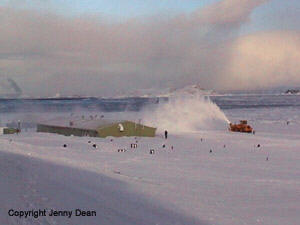
Rothera Research Station
- UK - Adelaide Island, Antarctic Peninsula - September
2001 - Bonner Marine Laboratory Fire
In preparation
for the arrival of the aeroplanes arriving at the start
of the summer, the runway is cleared of snow by the snow
blowers. This photo was taken 18 days before the Bonner
Laboratory was reduced to rubble by a major fire. Attempts
were made to try to put the fire out, which included snowblowing
as in this picture; but to no avail.

The laboratory
building already consumed by fire, this is the moment that
the roof was blown off. The miserable day happened to also
be the windiest of the winter with winds gusting up to 80+
knots. Fire is a major threat on base, this one caused by
an electrical fault, and is very difficult to tackle once
it takes hold. Prevention of injury to personnel is paramount,
and luckily here no one was hurt. However,
the scientific
work was severely affected.
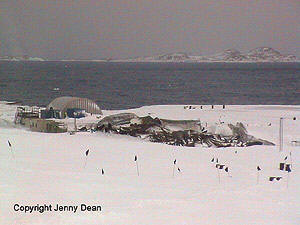
This is what
was left of the laboratory building at Rothera, on the peninsula,
that had been consumed by fire the day before.
Words
and pictures by Jenny Dean
Scott Research Station
- New Zealand - McMurdo Bay - May 2009 - A-Frame
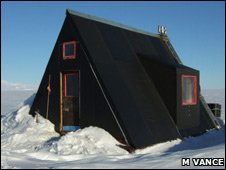
24
May 2009
MEDIA STATEMENT
A FRAME
HUT FIRE IN ANTARCTICA
The iconic A Frame Hut near Scott Base, Antarctica
burnt down on Saturday evening. A routine inspection
and change over of diesel fuel tanks, which supplied
the heating to the hut, was being completed by Scott
Base Staff. Upon re-ignition of the heater the priming
fuel flashed over and set fire to the hut. Attempts
to fight the fire proved futile as the timber and bitumen
hut burnt quickly.
Chief Executive of Antarctica
New Zealand, Lou Sanson said, "We are extremely
thankful that no one was seriously injured in the fire.
It is a testimony to the skill of our staff that they
were able to think quickly and remove themselves from
harm."
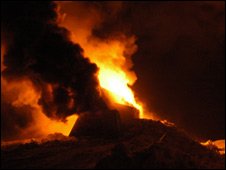
The
A Frame Hut had become an icon of the modern Antarctic
era. It was moved out onto the Ross Ice Shelf in 1971
from the McMurdo Station ice wharf. Discarded by the
United States Antarctic Programme, the Kiwis of Scott
Base quickly made it their own. It was primarily used
as a base for field training and as a retreat for the
staff of Scott Base. The A Frame Hut has housed many
notable New Zealand scientists, artists and politicians,
and was the favourite haunt of Sir Edmund Hillary.
Lou Sanson said, "The A Frame represented something
uniquely Kiwi in Antarctica. It was the concept of a
mountain hut mixed with a bach and it said something
about who we are. The A Frame Hut will be sadly missed
by all those who have been part of the New Zealand Programme
in Antarctica over the last 38 Years".
Ends
Progress Research
Station - Russia - Larsemann Hills/Prydz Bay, East
Antarctica - October 5th 2008 - Two Story Building
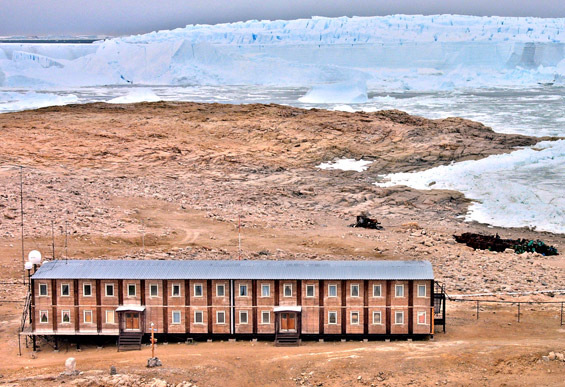 Photo Credit: Hannes Grobe/Alfred Wegener Institute |
MOSCOW, October 9 (RIA Novosti)
A two-story building,
part of Russia's Progress station in Antarctica, caught
fire killing one construction worker and seriously injuring
two others, the expedition's head said on Thursday.
Valery Lukin said the fire broke out on
Sunday on the station, where 29 people are based, completely
destroying the radio equipment, which made it impossible
to contact Russian officials about the incident until Thursday.
"All the radio equipment was destroyed.
One of the station's construction workers... died, and two
others received serious fractures and injuries," Lukin
said.
The injured have been taken to a nearby
clinic and are receiving the necessary medical treatment. "There
is no need for an evacuation due to medical concerns,"
Russia's Arctic and Antarctic Research Institute said in
a statement.
The earliest date that an evacuation could
be carried out is early November.
An investigation into the fire is being
carried out.
The Progress research
station was opened in 1989 and is located in the Larsemann
Hills in East Antarctica. The station is around 1.5 kilometers
from China's Zhong Shan research station, where the
injured Russians are receiving medical treatment.ENDS
The personnel on the base at the time
were unable to cope with the fire and the building was completely
destroyed by the fire. "There is no need for an evacuation
due to medical concerns," Russia's Arctic and Antarctic
Research Institute, which oversees the RAE program, said
in a statement through Novosti the Russian State News Agency "At present, the station team lives
in the old, small houses left by previous builders. The
fire did not spread to the other station facilities, so
we have the mess hall and the galley, the medical unit, 'warm'
and 'cold' warehouses, all transport vehicles and
also the facilities of the new wintering station under construction,"
Valery Lukin, head of RAE said. "All food, fuel and medical supplies
were preserved," Lukin added. "The people are
provided with normal meals, polar clothing and medical service."
Arson
I wintered over at McMurdo
in 1981 with the Naval Support Force. I was a Utilitiesman
2nd class assigned to the Maintenance Division.
Sometime in October, at a very late hour,
one of my buddies and I were walking from the PO Club and
noticed smoke coming from the Chapel. He ran back to the
club and notified the Fire House who were on the scene within
3 minutes. While he was doing this, I was able to get inside
and pull some of the pews away from the fire and when my
buddy returned, we were able to pull a rug that was in flames
out the back door before the Firemen arrived. Fortunately,
only a small portion of the interior was damaged and was
rebuilt the following summer. After the fire was put out,
the Firemen could not find a cause and were baffled.
It was the next day that we found out
that it was actually an attempted arson committed by one
of our Winter Over friends who had become intoxicated and
chose to commit this act in order to be flown out quicker
than he had been originally scheduled. Another buddy of
mine had seen him run out of the chapel but did not see
any smoke or flame and thought nothing of it at the time
so he went on to his quarters. He came forward the next
morning after hearing what had happened and told of what
he saw and thus the story goes.
I do not choose to reveal the arsons name
seeing how this was an occurrence of 28 years ago. I can
tell you that he was a Naval 1st Class Petty Officer who
got his wish and was flown out at first flight, did not
R&R in ChCh, and was flown directly back to the states
where he was charged. I do not know the outcome of the charges.
No comments:
Post a Comment